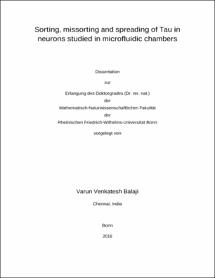Balaji, Varun Venkatesh: Sorting, missorting and spreading of Tau in neurons studied in microfluidic chambers. - Bonn, 2017. - Dissertation, Rheinische Friedrich-Wilhelms-Universität Bonn.
Online-Ausgabe in bonndoc: https://nbn-resolving.org/urn:nbn:de:hbz:5n-48017
Online-Ausgabe in bonndoc: https://nbn-resolving.org/urn:nbn:de:hbz:5n-48017
@phdthesis{handle:20.500.11811/7235,
urn: https://nbn-resolving.org/urn:nbn:de:hbz:5n-48017,
author = {{Varun Venkatesh Balaji}},
title = {Sorting, missorting and spreading of Tau in neurons studied in microfluidic chambers},
school = {Rheinische Friedrich-Wilhelms-Universität Bonn},
year = 2017,
month = sep,
note = {Tau is a microtubule-associated protein which plays an important role in stabilizing microtubules (Mandelkow and Mandelkow, 2012). Tau is mainly an axonal protein but it is missorted into the somatodendritic compartment in Alzheimer disease (AD). This represents one of the earliest signs of neurodegeneration in AD (Braak et al., 1994). During early stages of development, Tau protein is ubiquitously expressed in all compartments of neurons whereas it becomes axonally sorted during differentiation and maturation (Zempel and Mandelkow, 2014). We investigated the sorting mechanisms of endogenous Tau in cultured primary neurons using microfluidic devices (MFCs) where cell compartments can be treated and observed separately. We found that blocking protein degradation pathways on the neuritic side of the microfluidic devices with the proteasomal or autophagy inhibitors (e.g. wortmannin, epoxomicin) increased the missorting of Tau into the dendrites on the neuritic side. This suggests that degradation of Tau in dendrites is a major determinant for the physiological axonal distribution of Tau. Notably, such missorted dendritic Tau showed a different phosphorylation pattern from axonal Tau, as it was phosphorylated mainly in the repeat domain (epitope of 12E8 antibody), but not in the proline-rich domains flanking the repeats (e.g. epitopes of PHF1 and AT8 antibodies). By contrast, the axonal Tau was phosphorylated at all three sites. The dendritically mislocalized Tau resulted in the loss of spines. Inhibition of local protein synthesis prevented the missorting of Tau-induced by inhibition of protein degradation, indicating that the missorted dendritic Tau is locally synthesized. In support of this, Tau mRNA was detected not only in cell bodies and axons but in dendrites as well. Taken together, the above results indicate that the protein degradation systems play an important role in the polarized distribution of Tau in neurons during differentiation.
Another hallmark of Tau-dependent pathology in Alzheimer disease is its spreading between anatomically connected neurons and brain regions in a stereotypic pattern (Braak stages). This implies a release of Tau into the extracellular space and re-uptake by other neurons (Wang and Mandelkow, 2016). The mechanism of Tau spreading is still a matter of debate. In the present study, we used microfluidic devices and showed that the transneuronal transfer of Tau protein can be achieved by exosomes (small membrane-bounded vesicles containing Tau) depending on synaptic connectivity. The spreading of GFP-Tau containing exosomes was demonstrated directly by their uptake into neurons on the somal side, followed by transfer to second-order and third-order neurons in successive compartments of the MFCs. This implies the role of exosomes in the long distance spreading of Tau protein across different brain regions.},
url = {https://hdl.handle.net/20.500.11811/7235}
}
urn: https://nbn-resolving.org/urn:nbn:de:hbz:5n-48017,
author = {{Varun Venkatesh Balaji}},
title = {Sorting, missorting and spreading of Tau in neurons studied in microfluidic chambers},
school = {Rheinische Friedrich-Wilhelms-Universität Bonn},
year = 2017,
month = sep,
note = {Tau is a microtubule-associated protein which plays an important role in stabilizing microtubules (Mandelkow and Mandelkow, 2012). Tau is mainly an axonal protein but it is missorted into the somatodendritic compartment in Alzheimer disease (AD). This represents one of the earliest signs of neurodegeneration in AD (Braak et al., 1994). During early stages of development, Tau protein is ubiquitously expressed in all compartments of neurons whereas it becomes axonally sorted during differentiation and maturation (Zempel and Mandelkow, 2014). We investigated the sorting mechanisms of endogenous Tau in cultured primary neurons using microfluidic devices (MFCs) where cell compartments can be treated and observed separately. We found that blocking protein degradation pathways on the neuritic side of the microfluidic devices with the proteasomal or autophagy inhibitors (e.g. wortmannin, epoxomicin) increased the missorting of Tau into the dendrites on the neuritic side. This suggests that degradation of Tau in dendrites is a major determinant for the physiological axonal distribution of Tau. Notably, such missorted dendritic Tau showed a different phosphorylation pattern from axonal Tau, as it was phosphorylated mainly in the repeat domain (epitope of 12E8 antibody), but not in the proline-rich domains flanking the repeats (e.g. epitopes of PHF1 and AT8 antibodies). By contrast, the axonal Tau was phosphorylated at all three sites. The dendritically mislocalized Tau resulted in the loss of spines. Inhibition of local protein synthesis prevented the missorting of Tau-induced by inhibition of protein degradation, indicating that the missorted dendritic Tau is locally synthesized. In support of this, Tau mRNA was detected not only in cell bodies and axons but in dendrites as well. Taken together, the above results indicate that the protein degradation systems play an important role in the polarized distribution of Tau in neurons during differentiation.
Another hallmark of Tau-dependent pathology in Alzheimer disease is its spreading between anatomically connected neurons and brain regions in a stereotypic pattern (Braak stages). This implies a release of Tau into the extracellular space and re-uptake by other neurons (Wang and Mandelkow, 2016). The mechanism of Tau spreading is still a matter of debate. In the present study, we used microfluidic devices and showed that the transneuronal transfer of Tau protein can be achieved by exosomes (small membrane-bounded vesicles containing Tau) depending on synaptic connectivity. The spreading of GFP-Tau containing exosomes was demonstrated directly by their uptake into neurons on the somal side, followed by transfer to second-order and third-order neurons in successive compartments of the MFCs. This implies the role of exosomes in the long distance spreading of Tau protein across different brain regions.},
url = {https://hdl.handle.net/20.500.11811/7235}
}






